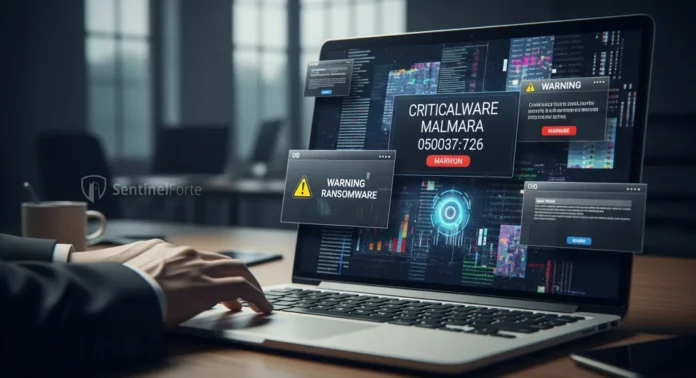Malware, or malicious software, represents one of the greatest cybersecurity threats facing the digital world today, impacting individuals, businesses, and governments alike. From viruses and worms to ransomware and spyware, malware manifests in numerous forms, each carrying unique dangers. In this comprehensive guide, we’ll dive deep into the world of malware—exploring its types, methods of infection, signs of an infection, preventative strategies, and how to respond effectively if infected.
Before exploring the various types of malware and strategies to combat them, consider this: Every single day, nearly 450,000 new malware samples are detected, with cybercriminals continuously innovating to evade detection and exploit new vulnerabilities. As we become increasingly interconnected through devices and networks, the importance of understanding malware becomes vital for securing our digital lives.
Let’s begin by clearly defining what malware is.
Defining Malware
Malware refers broadly to any software intentionally created to cause damage, disrupt normal operations, steal data, or gain unauthorized access to computer systems. Cybercriminals and malicious actors typically use malware for financial gain, espionage, sabotage, or simply disruption. Malware comes disguised in legitimate-looking software, embedded in email attachments, or through infected websites, making vigilance crucial.
Common Types of Malware
To effectively combat malware, one must understand the variety of forms it can take:
1. Viruses
Viruses attach themselves to legitimate files or programs. Once activated, they replicate and spread, often corrupting or modifying files on a user’s system. They typically require user interaction to activate, such as opening an infected attachment.
2. Worms
Unlike viruses, worms spread autonomously across networks without human intervention, exploiting vulnerabilities in systems or software to replicate rapidly.
3. Trojans
Trojans masquerade as harmless or desirable software, tricking users into installing them. Once installed, they create backdoors for attackers to remotely control systems, steal data, or deploy additional malware.
4. Ransomware
Ransomware encrypts user files and demands payment (usually in cryptocurrency) for the decryption key. This malware type has become notorious due to its severe impact on businesses and critical infrastructure.
5. Spyware
Spyware secretly monitors user activity, capturing keystrokes, browsing history, and personal data, which attackers can exploit for identity theft, fraud, or espionage.
6. Adware
Adware delivers unwanted advertisements and pop-ups. While not always directly harmful, adware can severely degrade user experience, slow down systems, and sometimes serve as a conduit for more dangerous malware.
7. Rootkits
Rootkits hide malicious activity from users and antivirus tools by embedding deep within a system’s operating environment, making detection and removal particularly challenging.
8. Bots and Botnets
Bots are compromised devices remotely controlled by attackers. Multiple infected devices form a botnet, capable of large-scale attacks such as Distributed Denial of Service (DDoS).
How Malware Spreads
Malware uses various methods of infection, including:
- Phishing Emails: Fraudulent emails designed to deceive recipients into clicking malicious links or downloading attachments.
- Malicious Websites: Visiting compromised or maliciously crafted websites can automatically download malware.
- Software Vulnerabilities: Outdated software and operating systems with known vulnerabilities can be exploited by attackers.
- USB Drives and External Media: Malware can spread via infected removable storage devices.
- Freeware and Pirated Software: Downloading software from unverified sources significantly increases malware risk.
Recognizing Malware Infection
Early detection is essential. Signs of malware infection include:
- Significant slowdown in system performance
- Frequent crashes or freezes
- Unauthorized pop-ups and advertisements
- Unusual network activity
- Changes to browser settings or homepage
- Unexplained loss of storage space or corrupted files
Preventative Strategies
The best malware defense is a proactive strategy:
Regular Updates
Keep your operating system, software, and applications regularly updated to patch known vulnerabilities.
Antivirus and Anti-Malware Software
Use reputable security software that provides real-time protection, regularly scanning and removing threats.
Secure Web Browsing
Employ secure browsing practices, including HTTPS sites and reputable browser security extensions.
Email Security
Train yourself and your team on recognizing phishing and scam emails. Never open attachments or links from unknown senders.
Backup Your Data
Regularly backup critical data offline or via cloud storage to safeguard against data loss due to malware.
Responding to Malware Infection
If your system becomes infected, prompt action can minimize damage:
- Disconnect from the Internet: Immediately isolate the infected device from the network to prevent further spread.
- Run Malware Scans: Perform a full scan using updated antivirus software to detect and remove threats.
- Restore from Backup: Use a clean backup to restore affected files if possible.
- Seek Expert Help: If malware persists or is particularly severe, engage professional cybersecurity services to assist with remediation.
The Economic Impact of Malware
Malware attacks cost global economies billions annually, with ransomware alone projected to reach $42 billion in global damage by 2025. Downtime, data breaches, and recovery expenses significantly burden businesses, underscoring the need for robust cybersecurity measures.
Regulatory and Legal Considerations
Compliance with data protection regulations (such as GDPR and CCPA) becomes paramount. Companies failing to secure data effectively can face severe fines, lawsuits, and reputational damage.
Real-World Case Studies
- WannaCry (2017): The notorious worm ransomware infected over 200,000 systems across 150 countries, causing significant disruptions to healthcare and financial sectors.
- SolarWinds (2020): A sophisticated malware attack compromised numerous U.S. government agencies and Fortune 500 companies, highlighting supply-chain vulnerabilities.
Expert Opinions
Cybersecurity experts consistently stress vigilance and preparedness. According to cybersecurity thought leader Bruce Schneier, “Security is a process, not a product.” Maintaining a continuous and evolving defense strategy is critical against persistent malware threats.
Malware remains a dynamic, evolving threat to digital security, requiring ongoing vigilance, education, and proactive defense strategies. By understanding the complexities of malware, recognizing infection signs early, and employing robust protective measures, individuals and organizations can significantly mitigate risk and secure their digital landscapes effectively.

